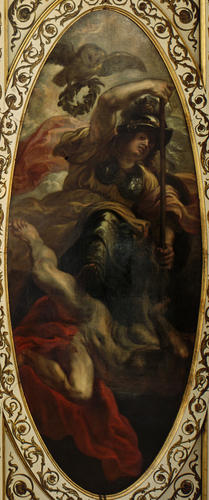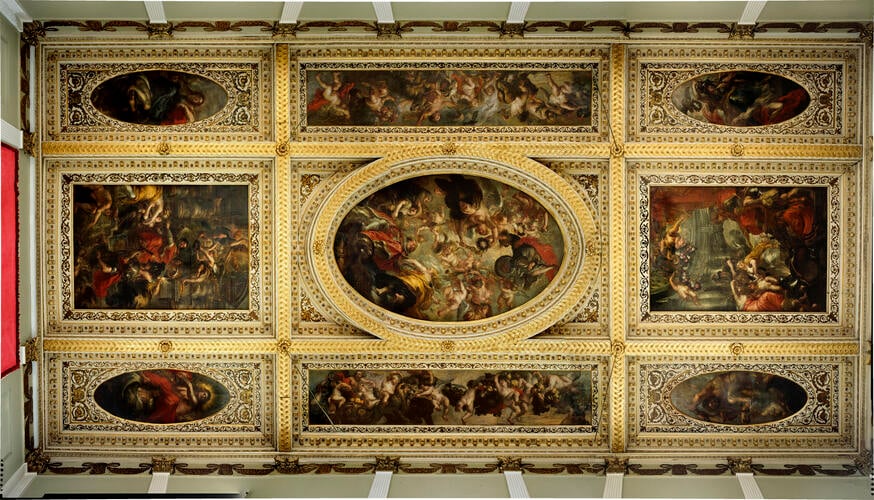Minerva, or Wisdom striking Ignorance c. 1632-4
Oil on canvas | 549 x 239 cm (support, canvas/panel/stretcher external) | RCIN 408419

Sir Peter Paul Rubens (1577-1640) and studio
Minerva, or Wisdom striking Ignorance c. 1632-4
Royal Collection Trust/© His Majesty King Charles III 2022. Photograph: Historic Royal Palaces

Sir Peter Paul Rubens (1577-1640) and studio
The Wise Rule of James I c. 1632-4
Royal Collection Trust/© His Majesty King Charles III 2024. Photograph: Historic Royal Palaces


-
In 1619 James I commissioned Inigo Jones, Surveyor of the King’s Works, to design a new Banqueting House after the destruction of an earlier building by fire in January of that year. Although the new Banqueting House appears in the background of a portrait of the King dating from c.1620 (RCIN 404446) in fact construction was delayed by the availability of Portland stone, and it was not officially completed until 1622. In design the new building showed the influence of Andrea Palladio, and followed the language of classical architecture, with a light-filled double cube hall positioned above a vaulted ground story – a dramatic contrast to the rambling Tudor structures that made up the rest of Whitehall Palace. The hall was to serve as a magnificent presence chamber for great state occasions, and Jones’s vision for a painted ceiling was undoubtedly also influenced by his travels in Italy, where he would have seen council rooms in Italian palaces similarly decorated to honour their occupants. The Banqueting House provided the setting for a variety of royal events including public audiences between the King and visiting ambassadors, as well as courtly masques - although these were stopped once the paintings were installed to avoid damage from candle smoke.
By 1621 Peter Paul Rubens had established a reputation as the leading artist in Northern Europe, and it was in that year that the subject of the commission to paint the ceiling of the new Banqueting House was first raised with him. During the 1620s however Rubens was largely preoccupied with other commissions (most notably the Life of Marie de Médicis series for the Palais du Luxembourg in Paris), as well as various diplomatic missions on behalf of the Archduchess Isabella and her nephew Philip IV of Spain.
Although discussions were well underway as to the subject matter of the series for the Banqueting House ceiling by the time of James I’s death in 1625, two surviving manuscripts in the British Library specifying the iconographical programme indicate that the project become significantly more ambitious in conception during the early years of the reign of Charles I. The series can be collectively titled the Glorification of King James I. It celebrates James I’s wise rule and peaceful reign, particularly his involvement in the Union of the Crowns that brought Scotland and England under one royal house. More broadly the scheme was designed to enhance the prestige of the House of Stuart, emphasising the fundamental notion of Divine rule by depicting the King’s Apotheosis and the symbols of monarchy.
The commission seems to have been formally awarded to Rubens while he was in England for eight months in 1629-30 acting as the diplomatic envoy of Philip IV, during which time the artist was also knighted by Charles I. Rubens worked through his ideas for the composition with a series of modelli oil sketches, the earliest being the Multiple Sketch (Tate, London). The final design for the series was sent to Charles I for approval in 1632, with adjustments made according to the King’s wishes so as to incorporate all the symbols of majesty. The three largest central canvases include posthumous portraits of James, each with different expression and pose, while the four corner ovals represent the triumph over vice of those attributes considered vital for successful rule, namely heroic virtue, wisdom, temperance and liberality. In this canvas the helmeted Minerva, personifying Wisdom, strikes Ignorance with her spear, while in the background an owl carries a laurel wreath.
The huge canvases were produced in Rubens’s workshop in Antwerp and by August 1634 all nine had been completed. Much of the work will have been executed by studio assistants working to Rubens’s designs, with the master overseeing to ensure consistency in style, retouching where necessary and undertaking the final details, flourishes and highlights. Although the contract specified that Rubens himself supervise the transportation and installation of the canvases into their final positions within the ornately carved, painted and gilded ceiling, in fact this complex task was delegated to a deputy. Once on the scaffold, the discovery that the measurements had not been correctly translated necessitated significant modifications to several of the canvases in situ. It also explains why some elements towards the edges are concealed by the frames. However, by March 1636 Rubens wrote to a friend to report that all the paintings had been installed and that ‘his Majesty is completely satisfied with it.’
Today the paintings remain in their original setting in the ceiling of the Banqueting House, which - as an unoccupied royal residence - is managed by Historic Royal Palaces.Provenance
Commissioned by Charles I in memory of his father, James I
-
Medium and techniques
Oil on canvas
Measurements
549 x 239 cm (support, canvas/panel/stretcher external)
Category
Object type(s)
Other number(s)
CWLF add








